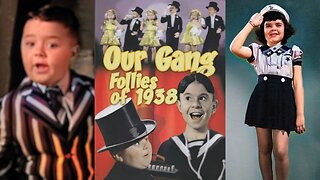THE GREAT GABBO (1929) Erich von Stroheim & Betty Compson | Drama, Musical, Romance | B&W
The Great Gabbo is a 1929 American Pre-Code early sound musical drama film directed by James Cruze, based on Ben Hecht's 1928 short story "The Rival Dummy", and starring Erich von Stroheim and Betty Compson.[1] The film features songs by Lynn Cowan, Paul Titsworth, Donald McNamee and King Zany.
Originally released by Sono Art-World Wide Pictures, certain sequences were presented in Multicolor.
SYNOPSIS
An insanely, egocentric ventriloquist, even though he is possessed by his wooden dummy, is in love with a dancer who is in love with another. The dummy gives advice to the ventriloquist.
Brilliant ventriloquist Gabbo increasingly uses his dummy "Otto" as his only means of self-expression—an artist driven insane by his work. Gabbo's gimmick is his astonishing ability to make Otto talk—and even sing—while Gabbo himself smokes, drinks and eats. Gabbo's girlfriend and assistant Mary loves him, but is driven to leave him by his megalomania, superstitions, irritability, and inability to express any human emotion without using Otto as an intermediary. In Otto's voice, Gabbo accepts the blame for Mary's leaving and recounts all the things she did for him, but as Gabbo he denies his feelings and tells the dummy to shut up.
Two years later, Gabbo has become a nationally renowned ventriloquist. He is revered for his talent, even as he is ridiculed for his eccentricity: he takes Otto with him everywhere he goes, even dining out with him, providing much entertainment to the restaurant patrons. Despite his success he continues to pine for Mary, who is now romantically involved with another singer/dancer, Frank. With both Mary and Frank performing in a show in which Gabbo is the headliner, he attempts to win her back. Mary is charmed by Gabbo's new romantic behavior, driving Frank to angry fits of jealousy. As his courtship meets with continued success, Gabbo increasingly expresses his emotions to Mary directly, without using Otto.
One day Gabbo finds that in his absence, Mary has straightened up his dressing room the way that she always used to. Convinced that she wants to come back to him, he confronts her with his feelings, admitting his loneliness without her and in the process revealing that he has grown past many of his old failings, such as his superstitions and obsession with his personal success. However, Mary tells him that she loves Frank, and has been married to him since before Gabbo came back into her life. She says that she missed Otto but not Gabbo, and in a last farewell she says, "I love you" to Otto.
CAST & CREW
Erich von Stroheim as The Great Gabbo
Betty Compson as Mary
Donald Douglas as Frank
Marjorie Kane as Babe
Directed by James Cruze
Screenplay by Hugh Herbert
Based on "The Rival Dummy" by Ben Hecht
Produced by James Cruze
Cinematography Ira H. Morgan
Music by Howard Jackson
Production company James Cruze Productions
Distributed by Sono Art-World Wide Pictures
Release date September 12, 1929
Running time 94 minutes
Country United States
Languages English
NOTES
Touted in advertising as an "all-dialog singing, dancing and dramatic spectacle", this early sound film oddly interleaves stark drama with gratuitous full-length, large-scale, on-stage musical production numbers such as "Every Now and Then", "I'm in Love with You", "The New Step", "The Web of Love", and the now-missing "The Ga Ga Bird", which was filmed in color. The "Web of Love" number, in which the performers wear stylized spider and fly costumes, is occasionally shown on Classic Arts Showcase. Footage from the dance sequences was re-used with different music in The Girl from Calgary (1932).
The public domain version available on Internet Archive runs 68 minutes, while the original film ran 96 minutes, including the exit music. The opening credits mention "Color sequences by Multicolor", but those sequences are now either lost or have survived only in black-and-white form. Multicolor, based on the earlier Prizma color process, went out of business in 1932; its assets were bought by Cinecolor.
The Great Gabbo opened to lukewarm reviews. Stroheim received good notices, but the film did nothing to further his career. Photoplay called the film "a bitter disappointment... Cruze seems to have lost his sense of humor, and the lighting and scenario are terrible."[4] The New York Times review commented unfavorably on the technical quality of the color sequences. Historian Arthur Lennig wrote that The Great Gabbo "betrays little inventiveness and shows few of its actors to advantage." He notes that, due to obvious budget constraints, several line-flubs by cast members made it into the final cut.
-
 21:23
21:23
Lost n Found Films
20 days agoOUR GANG FOLLIES (1938) George 'Spanky' McFarland, Carl 'Alfalfa' Switzer, Darla Hood | Comedy | B&W
59 -
 44:30
44:30
Michael Franzese
2 days agoCancel Culture Backlash of My UK Tour | Michael Franzese
79.5K45 -
 35:12
35:12
Island Hopper TV
1 day agoFull Costa Rica Travel Guide 2024
39.1K32 -
 4:43
4:43
ParisDemers
1 day agoThis Diet Hack Changed My Life! (How To Get Ripped FAST!)
54.6K46 -
 46:57
46:57
Crime Circus
1 day agoApple River ST*BBING!! Stand Your Ground Interrogation of Man in Wisconsin
62.6K45 -
 9:39
9:39
Tactical Advisor
1 day agoHow To Improve Your Shooting For FREE! Mantis Blackbeard X
77.8K14 -
 1:00:59
1:00:59
Squaring The Circle w/ Randall Carlson
1 day ago#007 The Real Climate Crisis Noone Is Talking About and Mount Tambora Pt 2
82.7K24 -
 13:52
13:52
America Uncovered
1 day agoEveryone is WRONG About Trump's Guilty Verdict
62.2K110 -
 13:10
13:10
Censored TV
1 day agoThe Owen Benjamin vs Jim Goad debate was WILD
66.2K51 -
 25:27
25:27
Degenerate Plays
21 hours agoThe Microtransaction Master - Call Of Duty Modern Warfare Remastered : Part 3
63.1K4